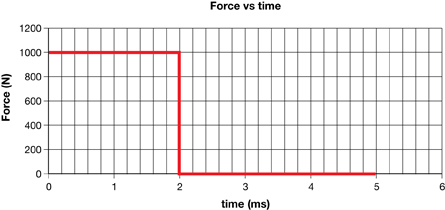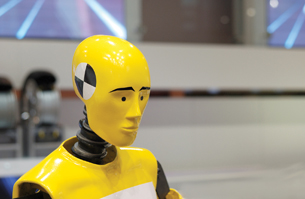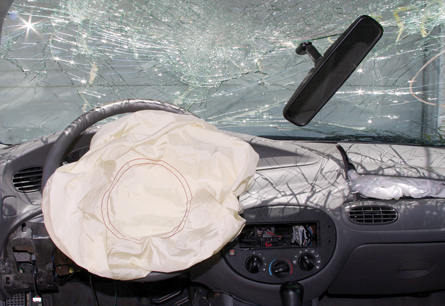Module 1
1. Module 1
1.13. Module Summary/Assessment
Module 1—Momentum and Impulse
 Module Summary
Module Summary

© Joseph/shutterstock
Module 1 explored the concepts of momentum and impulse as they relate to the function and design requirements of vehicle safety devices. In particular, we examined the phrase “speed kills” and how it is possible to reduce injury and death when a vehicle occupant experiences a large change in momentum during a collision.
Within this context the following questions were examined:
- What is momentum?
momentum: the product of the mass and velocity of an object
It is expressed as an equation:
![]()
Quantity |
Symbol |
SI Unit |
momentum |
|
kg·m/s |
mass |
m |
kg |
velocity |
|
m/s |
-
Why is momentum defined as a vector?
Momentum is the product of a vector (velocity) and a scalar (mass), so it is a vector quantity. The direction of the momentum vector is the same as the direction of the velocity vector.
-
How is momentum related to Newton’s laws?
Newton’s second law explains that the external, non-zero, net force acting on an object will be equal to the rate of change of the momentum of that object. This has particular relevance to situations involving large changes in momentum, such as those of vehicle collisions that occur at a high rate of speed.
Module 1 also explored the working principles of safety devices in the context of the following questions:
- What is impulse?
-
How is impulse related to a change in momentum?
impulse: the change in momentum, ![]() , and the product of net force and time
, and the product of net force and time
It is expressed in equation form:
![]()
Quantity |
Symbol |
SI Unit |
| impulse | N·s or kg·m/s | |
| net force | N | |
| time | t | S |
momentum |
|
kg·m/s |
mass |
m |
kg |
velocity |
|
m/s |
Since force and momentum are vector quantities, impulse is a vector quantity. The direction of the impulse vector is the same as the direction of the net force vector.
- How is impulse related to Newton’s laws?
By applying Newton’s second law, impulse can be described in terms of a change in velocity, caused by a non-zero (unbalanced) net force.

Impulse may also be represented graphically in the form of a force-time graph. In such cases, the product of force and time, or the impulse, is represented by the area of the graph.

We also learned that the force associated with a given impulse can be reduced by applying it over a greater time period, a principle related to the design of vehicle safety devices such as air bags and crumple zones.
 Module Assessment
Module Assessment

© trialart-info/shutterstock

© Melissa Brandes/shutterstock
Car safety has changed dramatically since Karl Benz invented the first gasoline-powered vehicle in 1885. The first cars had no safety devices. Drivers had to wear goggles to protect themselves from hitting birds and insects while driving. Windshields were made of plate glass that would shatter into pieces if hit. Today we take it for granted that all cars have seat belts, safety glass, and airbags. There are even cars with multiple airbags, night vision systems, back up cameras and/or sonar and cars, such as the Volvo XC60, that will stop themselves to prevent collisions. Car designers, scientists, and engineers are even working on cars that will drive themselves in the future.
Most of the improvements in safety are the result of crash test information that comes from crash test dummies. Today’s crash test dummies are the culmination of many decades of testing. From human volunteers to animal cadavers to modern dummies, the technology to simulate dangerous crashes has improved dramatically. Modern dummies come in multiple sizes to simulate humans from small babies up to large adults; they have joints and move like their human counterparts but are full of sensors to measure the accelerations and forces that they experience during a crash to determine how dangerous the collision would be for real people.
In a crash test, two test dummies with a mass of 77 kg each are placed in the test vehicle. The driver dummy has a seatbelt while the passenger dummy does not have a seatbelt. The vehicle is placed on a track and run into a wall at 56 km/h. Upon impact, everything comes to a halt.
- Calculate the impulse for each dummy during the collision. (Analytic 5 marks)
- The seatbelt brings the driver dummy safely to a halt whereas the passenger stops violently by hitting the dashboard and windshield. Draw a force vs time graph to demonstrate an example set of forces working on each dummy and show that the graphed impulse for each dummy matches the previous calculations. (Graphing 5 marks)
- Describe why the graph for each dummy is different and how those differences show that the driver dummy stops safely and the passenger dummy does not stop safely. (Holistic 5 marks)
This module assessment is similar to the types of questions asked on a diploma exam. It is designed to examine your knowledge and application of several skills and concepts from the first module. Before submitting your solution read the following rubrics and self-assessment questions. These are the same rubrics as used on the diploma exam.
If you have any questions about the marking guides or the question itself contact your teacher for guidance.
Analytic Question Scoring Guide
Graphing Question Scoring Guide